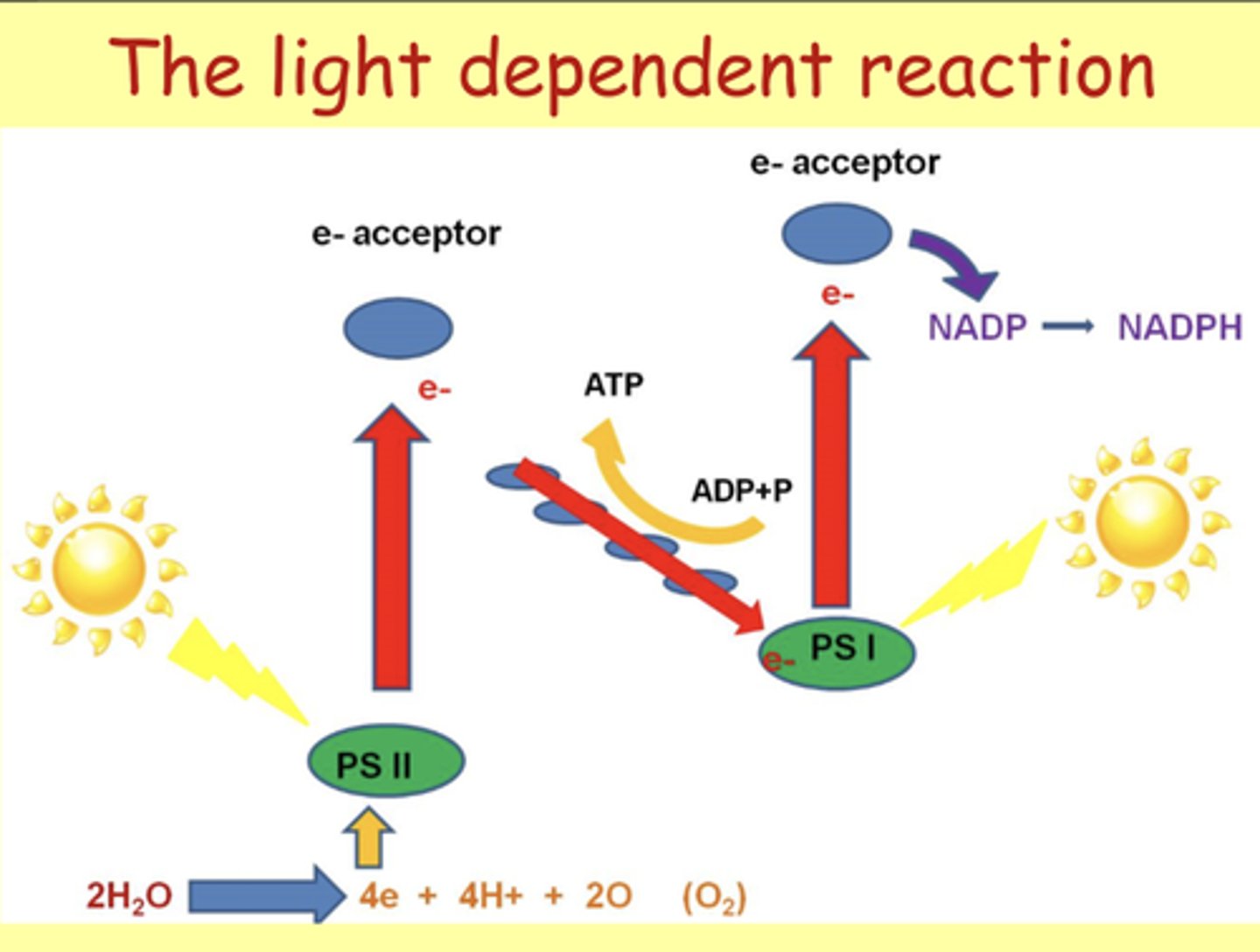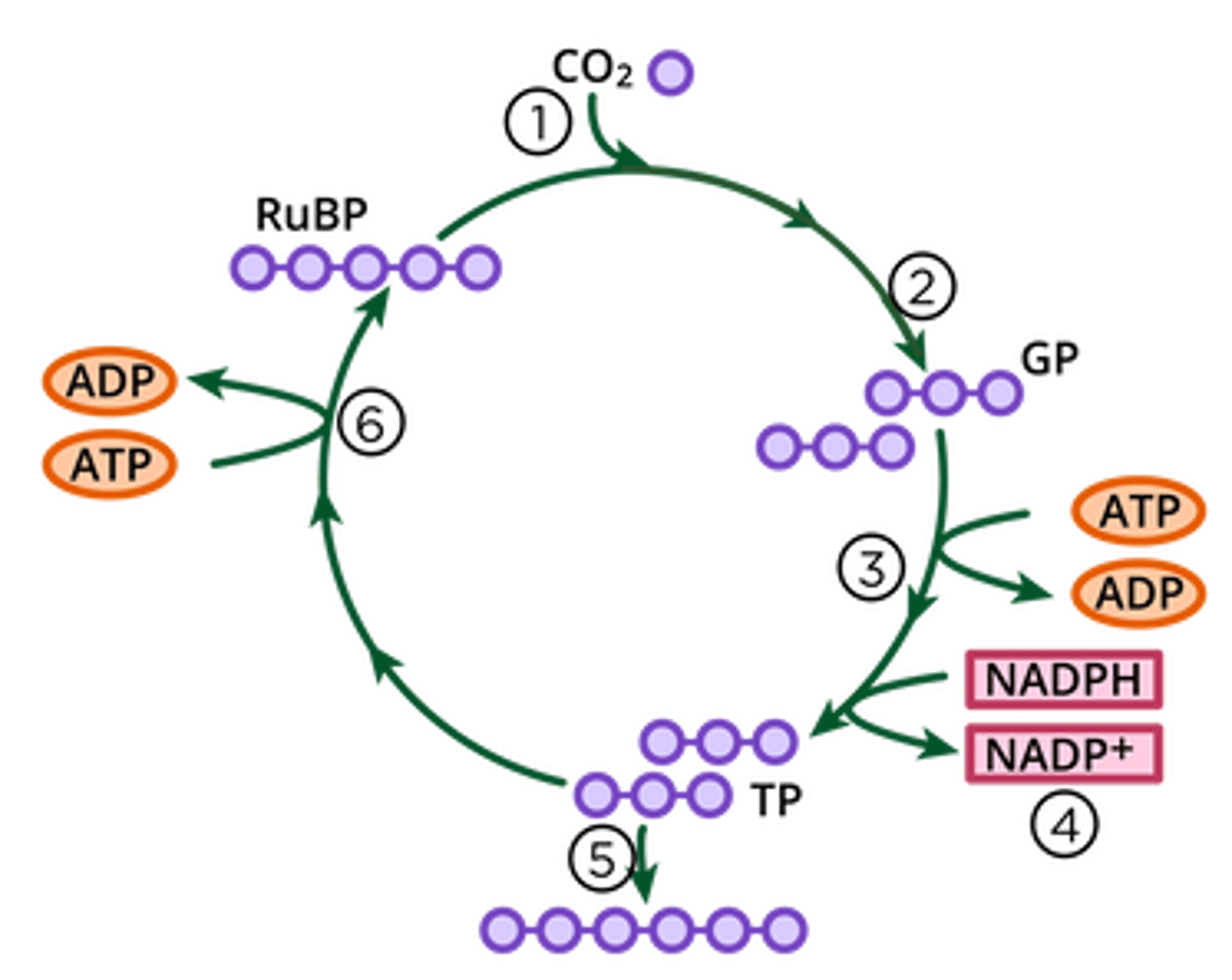StemUp: AQA A level Biology 3.5.1 Photosynthesis
1/18
There's no tags or description
Looks like no tags are added yet.
Name | Mastery | Learn | Test | Matching | Spaced |
|---|
No study sessions yet.
19 Terms
What are the two reactions that occur during photosynthesis? (2)
1. Light-dependent reaction
2. Light-independent reaction
Draw a diagram to showcase the processes involved in the light dependent reaction (5)
- PS I
- PS II
- E- acceptor(s)
- ADP + Pi -> ATP
- NADP -> NADPH

What chemicals are required for the light-dependent reaction of photosynthesis? (4)
- NADP
- ADP
- Pi
- Water
What are the first steps in the light-dependent reaction of photosynthesis? (3)
1. Chlorophyll absorbs light energy
2. This leads to the photoionisation of chlorophyll in photosystem 1 (PS1)
3. Which causes electrons to be released and promoted to a higher energy level
What happens to the electrons after they are promoted to a higher energy level in PS1? (2)
1. The electrons are passed from one carrier to another in the electron transport chain (ETC) at decreasing energy levels
2. Which causes energy to be released
How is the energy released from the electrons in the ETC used? (2)
- Used via the chemiosmotic theory
- By adding phosphate to ADP to form ATP - phosphorylation
What happens to the electrons after they release energy in the ETC? (2)
- They are accepted by NADP
- To form reduced NADP
What process produces protons, electrons, and oxygen during the light-dependent reaction of photosynthesis? (1)
Photolysis of water
Describe the chemiosmotic theory (4)
1. Energy transferred during ETC is used to actively pump protons from the stroma into the thylakoid
2. This causes a proton gradient to be established
3. Protons then diffuse down their concentration gradient into the stroma via the enzyme ATP synthase
4.The energy transferred by the movement of protons is used to phosphorylate ADP to form ATP
How does the light-dependent reaction aid the light-independent reaction? (4)
- Light-dependent reaction uses the reduced NADP from the light dependent reaction
- To form simple sugars
- The hydrolysis of ATP in the dependent reaction
- Provides the additional energy required for the light independent reaction
Explain why a factor that decreases the light-dependent reaction of photosynthesis leads to a decrease in the light-independent reaction (2)
- Less ATP produced from light-dependent reaction
- Less reduce NADP produced from light-dependent reaction
Draw a diagram to showcase the processes involved in the light-independent reaction (6)
I.E the calvin cycle

What happens to carbon dioxide in the light-independent reaction of photosynthesis? (3)
1. Carbon dioxide reacts with ribulose bisphosphate (RuBP)
2. To form two molecules of glycerate 3-phosphate (GP)
3. This reaction is catalysed by the enzyme rubisco
Where precisely is rubisco found in a cell? (1)
Stroma of the chloroplast
What role do ATP and reduced NADP play in the light-independent reaction of photosynthesis? (3)
- From the light-dependent reaction
- Are used to reduce glycerate 3-phosphate (GP)
- To triose phosphate
What happens to some of the triose phosphate produced in the Calvin cycle? (2)
Used to regenerate ribulose bisphosphate (RuBP)
What is another use of the triose phosphate in the light-independent reaction of photosynthesis? (1)
Converted to useful organic substances
What factors affect the rate of photosynthesis? (3)
- CO2
- Light
- Temperature (for enzymes)
Why do commercial greenhouses control factors that affect the rate of photosynthesis? (2)
- Controlled to an optimum
- To maximise yield potential